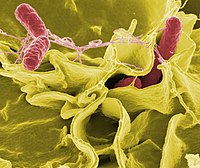
Photo from wikipedia
Avian pathogenic E. coli (APEC) caused avian colibacillosis is mostly common in poultry industry worldwide. APEC virulence factors lead to pathogenesis and the quorum sensing (QS) system is actively involved… Click to show full abstract
Avian pathogenic E. coli (APEC) caused avian colibacillosis is mostly common in poultry industry worldwide. APEC virulence factors lead to pathogenesis and the quorum sensing (QS) system is actively involved in the regulation of these virulence factors. Signaling molecules in QS are known as autoinducers (AIs). In QS-1, E. coli encodes a single LuxR homolog, i.e., SdiA, but does not express the LuxI homolog, an acyl-homoserine lactone (AHL) synthase of producing AI-1. Avian pathogenic E. coli (APEC) regulates its virulence genes expression in response to exogenous AHLs, but regulatory mechanisms of AHL and QS-1 are still unknown. This study targeted the APEC CE129 isolate as the reference strain, and the Yersinia enterocolitica yenI gene was expressed into APEC CE129. CE129/pyenI was conferred the ability to produce AHL signal. The CE129 SdiA mutant strain with an in-frame sdiA (AHL receptor) gene deletion was constructed by a λRed recombination system, which lost the ability to sense AHL. The goal of this study was to explore the function of QS-1 upon virulence and elucidate the regulatory effect of QS-1/AHL signals in the APEC strain. Adherence and invasion assays revealed that QS-1 affected APEC adherence and survival ability. APEC biofilm formation was also suppressed under C6HSL. Interestingly, APEC exhibited different phenotypes of acid tolerance and flagella expression when compared to enterotoxigenic E. coli or enterohemorrhagic E. coli (ETEC and EHEC, respectively). These findings enhance our understanding of the QS mechanism.
Journal Title: Archives of microbiology
Year Published: 2021
Link to full text (if available)
Share on Social Media: Sign Up to like & get
recommendations!